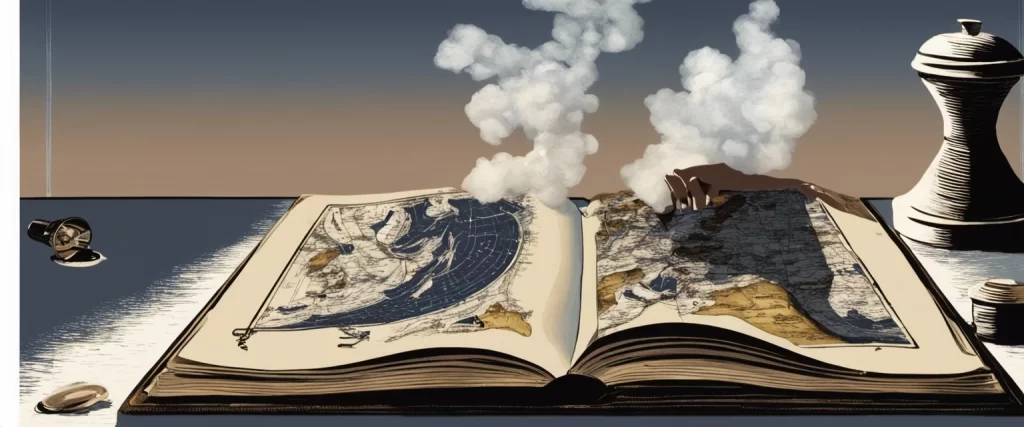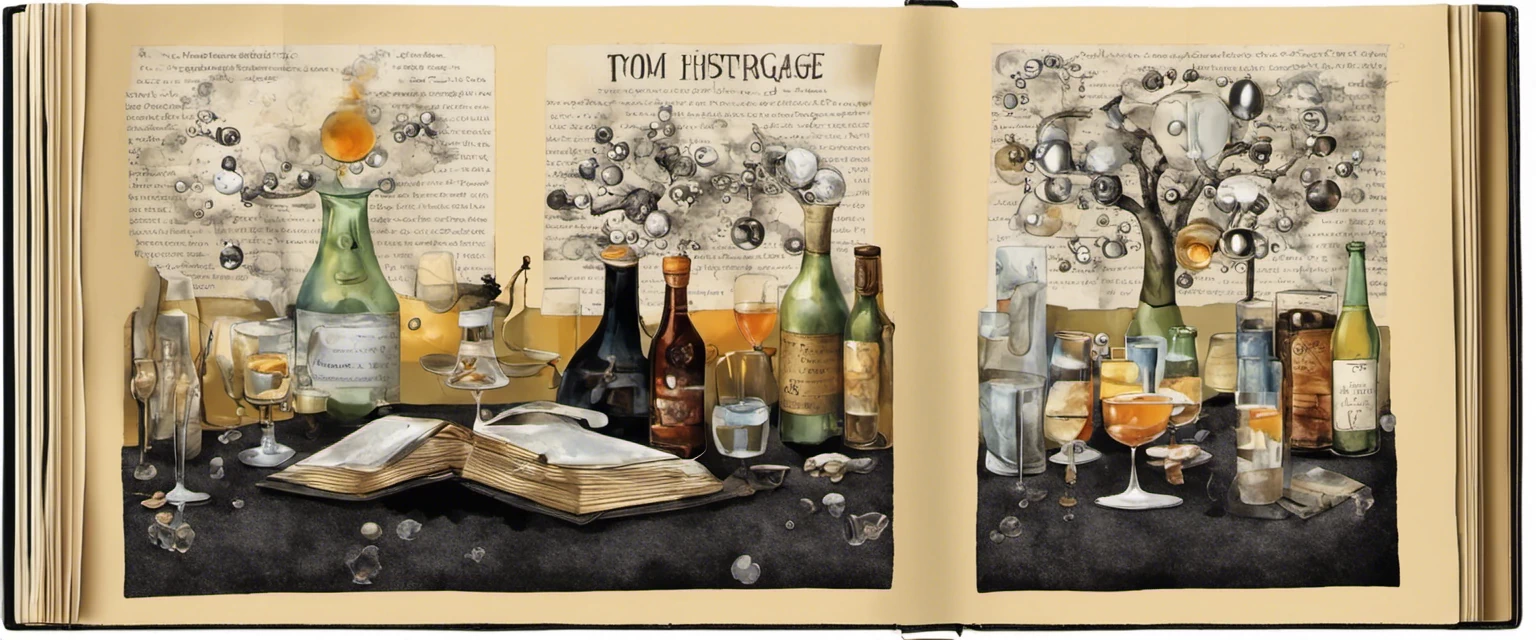—A History of the World in 6 Glasses & Salt
In the vast landscape of historical literature, there are few subjects as all-encompassing and fundamental to human civilization as food and drink. Just like language and warfare, the quest for sustenance and its subsequent cultural impact has shaped the course of human history. Acknowledging this profound connection, authors Tom Standage and Mark Kurlansky have embarked on separate yet strikingly parallel journeys to explore the pivotal role played by two specific elements: beverages and salt.
In “A History of the World in 6 Glasses,” Tom Standage takes readers on a captivating expedition through time and geography, tracing the influence of six iconic beverages: beer, wine, spirits, coffee, tea, and cola. Each of these beverages serves as a fulcrum upon which Standage skillfully balances the shifting forces of social, economic, political, and even religious development. From the ancient Sumerians, who brewed the first beer, to the global juggernaut of Coca-Cola in the 21st century, Standage unearths fascinating tales of power struggles, cultural exchange, revolutions, and human ingenuity, fundamentally altering our understanding of history itself.
In a similar vein, Mark Kurlansky’s “Salt: A World History” uncovers the hidden currents of civilization that have flowed through the ubiquitous mineral, salt. Often disregarded as a mere seasoning, Kurlansky compellingly argues that salt has held a paramount position throughout human development. Spanning continents and millennia, Kurlansky unravels how this ordinary crystal has played a pivotal role in trade, empire-building, customs, wars, and revolutions. From the establishment of ancient Chinese brine wells to the Salt March led by Mahatma Gandhi, Kurlansky paints a vivid tableau of the profound impact this humble crystal has had on human societies.
As we embark on a comparative study of Standage’s “A History of the World in 6 Glasses” and Kurlansky’s “Salt: A World History,” it becomes clear that both authors weave intricate tapestries of history, artfully intertwining the narratives of beverages and salt with the broader panorama of human existence. While Standage focuses on the transformative power of beverages, and Kurlansky delves into the identical potential of salt, their books share a common agenda: to unearth the overlooked stories hidden within everyday items, inviting readers to rethink the very fabric of our past and present.
Through the lens of these two renowned authors, we are invited to traverse time and space, witnessing the intricate connections between what we consume and the societies we shape. Together, Standage’s liquid litanies and Kurlansky’s mineral musings paint a comprehensive portrait of our shared human history, illuminating the webs of influence that extend far beyond the plate and the glass. With each turn of the page, we embark on a journey that is both enlightening and intoxicating, finding ourselves caught in the ripples of time and contemplating the profound impact that seemingly innocuous substances hold in our global narrative.
Brief Summary of Two Books
A History of the World in 6 Glasses by Tom Standage
“A History of the World in 6 Glasses” by Tom Standage explores the impact of six key beverages on human civilization. The book looks at the history and cultural significance of beer, wine, spirits, coffee, tea, and cola. Starting from the earliest civilizations in Mesopotamia, the book takes the reader through different time periods and regions, demonstrating how these beverages played a crucial role in shaping societies, economies, politics, and even religious practices. Standage skillfully weaves together stories of conquest, trade, exploration, and invention surrounding these drinks, revealing their influence on major historical events and trends. The book not only provides an engaging and accessible history lesson but also offers insights into how beverages and their consumption have had a profound impact on human culture.
Salt: A World History by Mark Kurlansky
“Salt: A World History” by Mark Kurlansky is an engaging and comprehensive exploration of the impact of salt on human civilization throughout the ages. The book delves into the historical, economic, cultural, and political significance of salt, showcasing its role in shaping societies and economies around the world. Kurlansky traces the origins of salt mining and trade, from ancient China and Rome to the Middle East and North America, highlighting its association with power, wealth, and warfare. He discusses the importance of salt as a preservative and seasoning, as well as its connections to religious practices and rituals. Ultimately, “Salt” offers a compelling narrative that reveals the incredible influence this humble mineral has had on human history.
Comparison between Two Books

Similarities in ordinary commodities
In both “A History of the World in 6 Glasses” by Tom Standage and “Salt: A World History” by Mark Kurlansky, the authors explore the profound impact that seemingly ordinary commodities have had on human civilization throughout history. Although the books focus on different commodities (various beverages in Standage’s book and salt in Kurlansky’s book), there are several similarities in the ways these commodities have shaped societies worldwide.
1. Trade and Economics: Both books highlight the economic significance of the commodities they discuss. Each commodity became a valuable trade item, driving economic exchanges and influencing global markets. For example, the emergence of salt mines and salt trade routes played a crucial role in the growth of societies and fostered international commerce. Similarly, beverages like beer, wine, and tea became essential elements of trade networks, driving economic development and shaping global connections.
2. Societal Evolution: Both Standage and Kurlansky demonstrate how these commodities influenced societal changes. From the use of salt as a preservative, facilitating the expansion of civilizations, to the role of beverages in shaping social interactions, the authors show that these commodities were more than just substances. They became symbols of power, cultural identity, and social status, which played a significant role in shaping societal hierarchies and social structures.
3. Technological Advancements: Both books explore how the demand and necessity for these commodities drove innovation and technological advancements. The need for salt preservation techniques led to the development of salt pans, salt wells, and other methods. Similarly, the search for better storage and transport systems for beverages led to innovations such as pottery, glassware, and canning. These technological advancements not only improved the production and availability of these commodities but also had broader implications for other industries and societies as a whole.
4. Cultural Significance: Both Standage and Kurlansky emphasize the cultural significance of these commodities. Whether it is the role of beer in ancient Egyptian religious rituals or the creation of salt taxes and intricate salt ceremonies in various societies, the authors highlight how these commodities became intertwined with cultural practices, customs, and traditions. They became part of celebrations, ceremonies, and everyday life, reinforcing social bonds and cultural identities.
5. Power and Politics: Finally, both books explore how these ordinary commodities played a role in the exercise of power, politics, and empire-building. From the use of salt as a means of control and coercion, to the role of beverages in ceremonies and diplomatic negotiations, the authors illustrate how these commodities became tools of influence and means of asserting dominance in various societies and historical periods.
In summary, “A History of the World in 6 Glasses” and “Salt: A World History” shed light on the remarkable impact that everyday commodities have had on human history. They demonstrate the shared themes of trade, economics, societal evolution, technological advancements, cultural significance, and power dynamics that arise when seemingly ordinary items transform into pivotal components of human civilization.
Divergences in ordinary commodities
A History of the World in 6 Glasses by Tom Standage and Salt: A World History by Mark Kurlansky are both fascinating historical accounts that explore the role of ordinary commodities in shaping the world. While they delve into different substances, namely beverages and salt, there are several divergences between these books when it comes to their treatment of ordinary commodities.
1. Focus on Commodities:
– In “A History of the World in 6 Glasses,” Tom Standage explores the impact of six different beverages throughout history: beer, wine, spirits, coffee, tea, and Coca-Cola. The book takes a broader approach by examining the social, economic, and cultural changes brought about by these various drinks.
– On the other hand, “Salt: A World History” written by Mark Kurlansky centers solely on the importance of salt in different societies. The book presents a comprehensive narrative on salt’s influence on economy, trade, warfare, and even religious practices. It offers a more nuanced perspective, focusing on the significance of salt in various historical contexts.
2. Chronological Coverage:
– Standage’s book spans the entirety of human history, from ancient Mesopotamia to the present day. By focusing on beverages, it presents a continuous narrative that connects different epochs and civilizations.
– In contrast, Kurlansky’s “Salt” covers a wider temporal range, starting from prehistoric times and extending up to the present day. It offers a more fragmented exploration of different societies at various points in history, showcasing the significance of salt in both ancient and modern contexts.
3. Cultural Significance:
– Standage highlights the social and cultural impact that beverages have had on societies. He examines how beer and wine played vital roles in the development of agriculture and urbanization, how spirits were linked to colonization and globalization, and how coffee, tea, and Coca-Cola are linked to the rise of industrialization and consumerism.
– Kurlansky, in “Salt,” explores the cultural significance of this mineral through different civilizations’ use of salt in religious rituals, culinary traditions, and as a form of currency. He also discusses the role of salt in preserving food, influencing trade routes, and as a tool for empowering or oppressing societies.
In summary, while both books are excellent accounts that shed light on the historical importance of ordinary commodities, “A History of the World in 6 Glasses” and “Salt: A World History” differ in terms of their subject matter, chronological coverage, and cultural significance. Standage’s book explores the impact of beverages throughout history, while Kurlansky’s book solely focuses on salt. Standage provides a continuous narrative, while Kurlansky offers a more fragmented exploration of different time periods. Finally, Standage emphasizes the social and cultural impact of beverages, while Kurlansky examines the cultural significance of salt in various contexts.

Conclusion
Both “A History of the World in 6 Glasses” by Tom Standage and “Salt: A World History” by Mark Kurlansky are well-regarded books that offer unique perspectives on global history. The choice of which one is more worthy of reading depends on individual interests and preferences.
“A History of the World in 6 Glasses” explores the role of six significant beverages—beer, wine, spirits, coffee, tea, and Coca-Cola—in shaping human history. The book seamlessly blends history, anthropology, and cultural analysis, providing an engaging narrative that highlights the impact of these beverages on societies throughout time. It offers a concise yet comprehensive overview of world history through the lens of these drinks. If you enjoy learning about the interplay between culture, technology, and global events through a focused and accessible approach, this book may be more suitable for you.
On the other hand, “Salt: A World History” delves into the fascinating story of salt and its impact on human civilization. Kurlansky explores how this humble mineral has shaped economic, political, and cultural developments from ancient times to the modern era. The book covers a vast range of topics, including salt’s role in food preservation, as currency, and in religious rituals. If you have an interest in the intersection of food, economics, and history, and enjoy a more detailed exploration of a specific theme, “Salt” may be the better choice for you.
Ultimately, both books have their merits and offer unique perspectives on world history. It’s worth considering your specific interests before making a choice.



